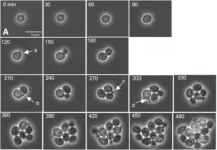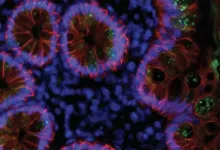(Press-News.org) HOUSTON -- Researchers from The University of Texas MD Anderson Cancer Center have developed the first comprehensive framework to classify small-cell lung cancer (SCLC) into four unique subtypes, based on gene expression, and have identified potential therapeutic targets for each type in a study published today in Cancer Cell.
SCLC is known for rapid, aggressive growth and resistance to treatment, which leads to poor outcomes. While recent advances in immunotherapy and targeted therapy have improved survival for non-small cell lung cancer (NSCLC), progress for SCLC has been limited.
"For decades, small-cell lung cancer has been treated as a single disease because the tumors all look similar under the microscope, even though they behave very differently," said Lauren Averett Byers, M.D., associate professor of Thoracic/Head & Neck Medical Oncology and senior author of the study. "Our study provides a transformative new system to define four major groups of small-cell lung cancer and, for the first time, an avenue for personalized treatment of the second most common type of lung cancer."
Four major subtypes of SCLC
Although previous research identified three possible subtypes of SCLC based on transcription factors, which indicate whether particular genes are turned "on" or "off," a large number of SCLC tumors didn't fit into one of the three groups. Rather than trying to apply a hypothesis to the remaining tumors, Byers' team took an unbiased bioinformatics approach--letting the data from a large set of SCLC tumor samples speak for itself. This led to a 1,300 gene "signature" that confirmed the three previously observed groups (A, N and P), plus a previously unrecognized fourth group (I) with a unique immune landscape.
The first three groups are defined by activation of the ASCL1 (SCLC-A), NEUROD1 (SCLC-N), and POU2F3 (SCLC-P) genes. The fourth type, SCLC-I, is characterized by an inflamed gene signature with a high expression of multiple immune genes, including significantly greater levels of genes indicating the presence of CD8-positive cytotoxic T cells.
"Our paper shows that the inflamed group has a distinct biology and environment and tends to be more responsive to immunotherapy," Byers said. "Identifying the inflamed group is very important because so far there have not been any validated biomarkers for small-cell lung cancer that predict which patients get the most benefit from immunotherapy."
Based on recent clinical trials, immunotherapy has become part of the standard of care for SCLC. However, all clinical trials for SCLC, including those using immune checkpoint inhibitors, have had limited success. This study could help explain why, as the results suggest different classes of drugs may be more effective in specific subtypes. For example, in the samples from this study, SCLC-I was most sensitive to immune checkpoint blockade, SCLC-A to BCL2 inhibitors, SCLC-N to Aurora kinase inhibitors and SCLC-P to PARP inhibitors.
"Immunotherapy plus chemotherapy is currently the backbone of treatment for all advanced small-cell lung cancer patients, but not all patients experience the same benefit," said Carl Gay, M.D., Ph.D., assistant professor of Thoracic/Head & Neck Medical Oncology and lead author of the study. "Our results provide an opportunity to think about immunotherapy approaches that are specific to the inflamed group, which has a very different microenvironment, separately from combination approaches that might activate the immune response in the other three groups."
Study methods and analysis
The research team first identified the four groups by applying non-negative matrix factorization to previously published data from 81 SCLC patients with surgically resected tumors. Most patients in this data set had early-stage disease, which is not typical. Because SCLC is so aggressive, it's most often diagnosed at an advanced stage. To validate the four subtypes in late-stage disease, Byers' team also analyzed data from 276 SCLC patients enrolled in the Phase III IMpower133 clinical trial, which established the current standard of care for advanced SCLC and represents the largest available SCLC data set to date.
"Looking at the bigger data set of what a more typical patient looks like, the four major groups came out very clearly again, including the novel inflamed group we identified," Byers said. "We also showed that you don't have to use the full 1,300 gene panel. We have developed immunohistochemistry tests that we're working toward adapting for the clinic to more quickly and easily classify SCLC tumors."
One of the known challenges of SCLC is that it often develops resistance to treatment, even after an initial response. To determine if "subtype switching" causes resistance, the authors used single-cell RNA sequencing to evaluate tumor evolution in a series of patient-derived SCLC models. The study suggests that SCLC-A tends to switch to SCLC-I after being treated with chemotherapy, which could contribute to treatment resistance.
A path toward personalized treatment for SCLC
Using the SCLC subtype framework in future clinical trials will be necessary to verify the study findings, particularly regarding the therapeutic vulnerabilities for each group.
"Now we can develop more effective strategies for each group in clinical trials, taking into account that they each have different biology and optimal drug targets," Byers said. "As a field, small-cell lung cancer is about 15 years behind non-small cell lung cancer's renaissance of biomarkers and personalized therapies. This represents a huge step in understanding which drugs work best for which patients and gives us a path forward for personalized approaches for small-cell lung cancer."
INFORMATION:
A full list of collaborating researchers and their disclosures is included in the paper. This research was supported by the National Institutes of Health/National Cancer Institute (CCSG P30-CA016672, T32 CA009666, R50-CA243698, R01-CA207295, U01-CA213273), The University of Texas Southwestern and MD Anderson Cancer Center Lung SPORE (5 P50 CA070907), Department of Defense (LC170171), Cancer Prevention & Research Institute of Texas (RP170067), The University of Texas MD Anderson Lung Cancer Moon Shots Program, Abell-Hangar Foundation, Andrew Sabin Family Fellowship, ASCO Young Investigator Award, The Hope Foundation, Khalifa Bin Zayed Al Nahyan Foundation and Rexanna's Foundation for Fighting Lung Cancer.
Older people in Japan have an "attitude of gratitude" which keeps them feeling hopeful despite the challenges of aging, a new study says.
Feeling thankful and grateful for the care and support they have had during their life helps pensioners in the country to be more optimistic, even when they experienced difficulties and were anxious about getting older, an expert found.
Dr Iza Kavedžija, from the University of Exeter, observed people in their 80s and 90s in the course of long-term ethnographic fieldwork in a merchant neighbourhood in the city of Osaka. Her research is published in the journal Anthropology and Aging.
Dr Kavedžija found many members of ...
Once regarded as merely cast-off waste products of cellular life, bacterial membrane vesicles (MVs) have since become an exciting new avenue of research, due to the wealth of biological information they carry to other bacteria as well as other cell types.
These tiny particles, produced by most bacteria, can bud off from outer cellular membranes, traveling along cell surfaces and occasionally migrating into intercellular spaces.Luis Cisneros is a researcher in the Biodesign Center for Biocomputing, Security and Society, and the BEYOND Center for Fundamental Concepts in Science, at Arizona state University.
In a new study, Luis H. Cisneros and his colleagues describe ...
DURHAM, N.C. -- Researchers at Duke University have developed a predictive theory for tumor growth that approaches the subject from a new point of view. Rather than focusing on the biological mechanisms of cellular growth, the researchers instead use thermodynamics and the physical space the tumor is expanding into to predict its evolution from a single cell to a complex cancerous mass.
The results appeared Jan. 15 in the journal Biosystems.
"When scientists think about cancer, the first thing that comes to mind is biology, and they tend to overlook the physical reality of ...
Indigenous peoples' lands may harbour a significant proportion of threatened and endangered species globally, according to University of Queensland-led research.
UQ's Dr Chris O'Bryan and his team conducted the first comprehensive analysis of land mammal composition across mapped Indigenous lands.
"These lands cover more than one-quarter of the Earth, of which a significant proportion is still free from industrial-level human impacts," Dr O'Bryan said.
"As a result, Indigenous peoples and their lands are crucial for the long-term persistence of the planet's biodiversity and ecosystem services.
"Despite this, we know relatively little about what animals, including highly imperilled species, may reside in or depend on these lands."
The team overlayed maps of Indigenous ...
ITHACA, N.Y. - Far below the gaseous atmospheric shroud on Saturn's largest moon, Titan, lies Kraken Mare, a sea of liquid methane. Cornell University astronomers have estimated that sea to be at least 1,000-feet deep near its center - enough room for a potential robotic submarine to explore.
After sifting through data from one of the final Titan flybys of the Cassini mission, the researchers detailed their findings in "The Bathymetry of Moray Sinus at Titan's Kraken Mare," which published in the Journal of Geophysical Research.
"The depth and composition of each of Titan's seas had already been measured, ...
University of Illinois Chicago is one of the U.S. sites participating in clinical trials to cure severe red blood congenital diseases such as sickle cell anemia or Thalassemia by safely modifying the DNA of patients' blood cells.
The first cases treated with this approach were recently published in an article co-authored by Dr. Damiano Rondelli, the Michael Reese Professor of Hematology at the UIC College of Medicine. The article reports two patients have been cured of beta thalassemia and sickle cell disease after their own genes were edited with CRISPR-Cas9 technology. The two researchers ...
New research from McMaster University has found that psychiatric help for mothers with postpartum depression results in healthy changes in the brains of their babies.
The study, published in the journal Depression and Anxiety this week, found treating mothers who had postpartum depression with cognitive behavioural therapy (CBT) not only helped the moms, but resulted in adaptive changes in the brains and behaviour of their infants.
More specifically, after the mothers' treatment, their infants showed healthy changes in their nervous and cardiovascular systems, and they were observed to better regulate their behaviours and emotions by both mothers and fathers.
"In fact, we found that after their moms were treated that their infant's ...
As the number of people who have fought off SARS-CoV-2 climbs ever higher, a critical question has grown in importance: How long will their immunity to the novel coronavirus last? A new Rockefeller study offers an encouraging answer, suggesting that those who recover from COVID-19 are protected against the virus for at least six months, and likely much longer.
The findings, published in Nature, provide the strongest evidence yet that the immune system "remembers" the virus and, remarkably, continues to improve the quality of antibodies even after the infection has waned. Antibodies produced ...
BIRMINGHAM, Ala. - University of Alabama at Birmingham polymer and radionuclide chemists report what they say "may represent a major step forward in microcapsule drug delivery systems."
The UAB microcapsules -- labeled with radioactive zirconium-89 -- are the first example of hollow polymer capsules capable of long-term, multiday positron emission tomography, or PET, imaging in vivo. In previous work, UAB researchers showed that the hollow capsules could be filled with a potent dose of the cancer drug doxorubicin, which could then be released by therapeutic ultrasound that ruptures the microcapsules.
PET imaging with zirconium-89 -- which has a half-life of 3.3 days -- allowed the capsules to be traced in test mice up to seven days. The major ...
NASA-funded research on the 11 largest freshwater lakes in the world coupled field and satellite observations to provide a new understanding of how large bodies of water fix carbon, as well as how a changing climate and lakes interact.
Scientists at the Michigan Tech Research Institute (MTRI) studied the five Laurentian Great Lakes bordering the U.S. and Canada; the three African Great Lakes, Tanganyika, Victoria and Malawi; Lake Baikal in Russia; and Great Bear and Great Slave lakes in Canada.
These 11 lakes hold more than 50% of the surface freshwater that millions of people and countless other creatures rely on, underscoring the importance of understanding how they are being altered by climate change and other factors.
The two Canadian lakes ...






